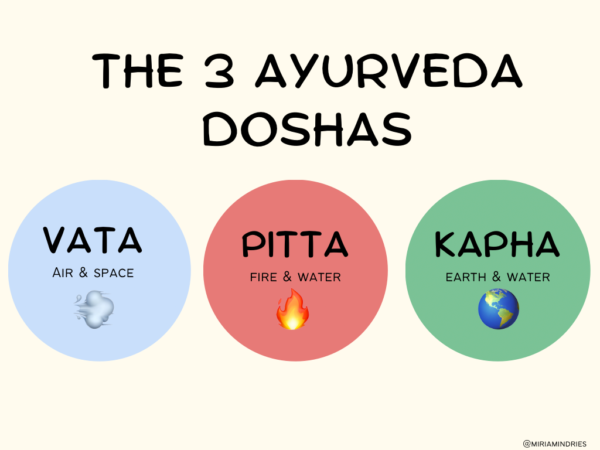Information


Ayurveda is a life science and a beautiful lifestyle that anybody can follow. It is said to be the oldest medical system in the world, dating 7000 years ago and starting from the Vedas. The Ayurvedic lifestyle focuses on bringing the body in complete balance, this includes the physical, mental, emotional and energetic self. Its primary focus starts with the 3 doshas, or body constitutions based on the universal elements of fire, water, earth, ether/space and air. These are apparent outside and within ourselves. Finding out your Ayurveda constitution is one of the key areas to focus on when wanting to start practicing this beautiful life science. Note that in Ayurveda like increases like, therefore finding out your dominant dosha will enable you to understand how you can restore your balance by following this principle.
So what are the three doshas? (Download the FREE Ayurveda dosha test at the end of this blog and find out yours)
Time of the day: 2pm – 6am; 2am – 6am.
The Vata constitution is represented by the elements of air and space. The season representing the Vata qualities is the period between late autumn to mid-winter, a time when the wind is strong and the weather is cold and humid/wet. This is what the body qualities of Vata are also. A person with a predominant Vata constitution is usually sensitive to cold climate (like increases like principle). Their skin tends to be quite pale and dry. Physically, they tend to be naturally quite tall and thin and they find it hard to put on weight. A Vata person has the qualities of air and space, meaning they can be very creative and are generally quite active. Think about the elements: air moves freely and sporadically and space is limitless. Vata’s primary functions are movement which comes from air and communication. When in balance, they can express their ideas freely such as those with a balanced Vishudi chakra. As they tend to be quite creative, they usually bring their ideas to life through art such as writing, painting, creative marketing campaigns, dancing etc. They are the thinkers of the three so a lot goes on in their mind. They have many ideas thanks to their creative streak and when in balance, this can bring out their talents, but when out of balance they can become anxious and paranoid and can isolate themselves when faced with a problem. When out of balance, they can also become very resistant to cold, have dry skin, dry lips and bite their nails; their appetite is also reflective of the air element, sometimes they wake up and feel like eating breakfast, other times they can just have a coffee and last without food until the later hours of the day. The Vata digestion is often sporadic and they can experience constipation often. The Vata stools are usually described as small blobs, sometimes hard to pass. To balance your Vata dosha, it’s important to slow down by taking a nice stroll in the park sometimes instead of intense power walking or running; to nourish your skin and physical body with a daily self-massage using sesame oil or any other heating oil; to eat more heating foods that are cooked meaning they are easier to digest such as soups and cooked vegetables; to meditate so that you give your mind a break and to create a sleep pattern which provides you with enough resting time. Because Vatas can be very much in their head, thinking a lot, they can experience insomnia and other sleep disturbances. So, it’s important to set a healthy sleeping ritual to which you stick to so that you can feel more in balance. Soaking your feet in hot water and doing some meditation before bed time are both wonderful ways of nourishing yourself and get ready for a deep, relaxing sleep.
Time of the day: 10am-2pm; 10pm-2am
The Pitta dosha has the primary elements of fire and water. The season representing pitta is summer, during the hottest times of the year usually from late spring until early autumn. A Pitta person is hot by nature, therefore they tend to have olive, rosey or tanned skin. Their physical body is usually medium size, in proportion and they find it easy to put on weight but also to lose weight. Due to the like increases like principle, they can be aggravated by heat due to their natural state, and they show this physically, mentally and emotionally. Pittas are quite reactive on all accounts, behaviourally and also physically. Their skin can break out in rashes or pimples when aggravated; they can easily get flustered or react in an angry or excited way, depending on the situation. This goes the same for their digestion. When balanced, a Pitta person can have healthy, medium to soft stools, however when aggravated (usually by hot foods) their stomach also reacts to it very quickly resulting mostly in lose frequent stools. The Pitta person has a very string appetite and usually become aggravated, frustrated or “hangry” if they skip a meal. The primary functions of Pitta are digestion and transformation. Think about the two elements representing Pitta – fire which has a strong, hot powerful presence and water which is strong, heavy and can be loud. A Pitta person is usually quite organised, well-spoken and confident in their abilities. They are usually the doers, they can plan and execute very well, making them great leaders. Due to their reactive nature, they can also allow stress to affect their state by taking a tough approach, meaning they keep going until they collapse of exhaustion or deplete their energy. Therefore, balancing Pitta with cooling foods and spices, a nice cool climate and a routine focused day is a great way to bring some equilibrium to your lifestyle. Pittas tend to be less sensitive when it comes to their emotional state, however when a Pitta is aggravated, watch out because the lion is out of the cage. They will express this without any means of holding back. In the opposite sense, they can hold emotions in by keeping busy with other activities, until one day when they let it all out. Maintaining a balanced exercise regime such as a consistent dynamic between running and yoga will bring your Pitta body in a more balanced state, allowing you to continue with your driven nature. To balance your physical body and nourish your skin, create a daily ritual of a 10-minute self-massage with a cooling oil, such as coconut oil.
Time of the day: 6am – 10 am; 6pm – 10pm.
The Kapha dosha has the primary elements of earth and water. The season representing Kapha is the cold winter period usually lasting until early spring. Kaphas are known as the nurturers of the three doshas. They are empathetic, kind and compassionate to others needs and also great listeners. The Kapha elements of earth and water provide them with a heavy type energy and physical body (heavy bone structure). This does not mean they are fat, this refers more to the body structure, the joints, the bones, the body frame. Although out of the three, Kaphas are usually the ones who put on weight very easily and find it difficult to lose weight. When in balance, Kaphas have a lovely energy about them, the type that makes everybody want to be around them. Being connected to the elements of earth and water, Kaphas are quite slow in their approach and actions. This also represents their digestion and mental state. A Kapha person can go without food for many hours, particularly if they feel out of balance, usually bringing qualities of feeling bloated and heavy. On a mental level, they tend to be slow learners, but once they grasp to something, they have the best memory and can retain the information quite easily. Kaphas definitely need their long sleep ins and early nights. Because of this, they can easily fall out of balance feeling sluggish and lazy. To keep your Kapha dosha in balance, it’s important to create and stick to a consistent daily exercise routine. This can involve, walking, running, dancing, a faster yoga flow; anything that moves the body, but particularly something that keeps you quite active and motivated. Kaphas need stimulation, so often they will drink coffee first thing in the morning, otherwise they feel like they cannot wake up. Always remember the qualities of their elements, slow and heavy. Foods to balance the Kapha digestion are usually ones that are light and easy to digest, nothing heavy. When out of balance, a Kapha person can have dry skin, be overweight, feel lazy and sluggish, depressed and unmotivated. A daily self-massage with sesame oil is wonderful for the Kapha skin, and try to make the massage strokes a little bit faster as this will create an active energy in the body.
There is so much information you can go into in order to understand your predominant Ayurvedic dosha. Please note that whilst most people will have one dosha as their predominant state, most of us tend to have all three doshas in some percentage. Sometimes, some people have two doshas that are equally dominant, rarely but possible all three, and some just one. The stages we go through in life also bring out specific predominant doshas. But to begin with, it’s always a good idea to become familiar with your constitution and start living a healthier, balanced state not by depriving yourself from foods, things and general life pleasures that you enjoy, but to understand and enhance your overall wellbeing at a physical, emotional and mental level.